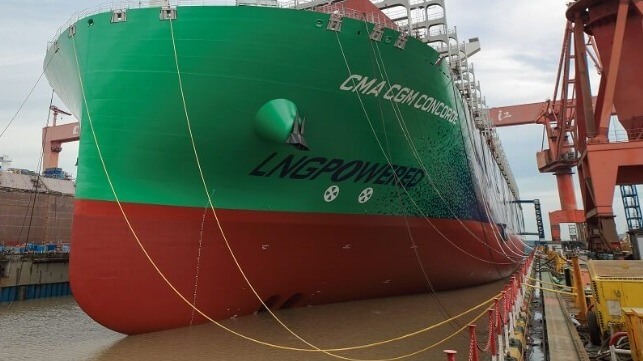Surge in Boxship Orders Could Create Capacity Surplus as Early as 2023

Although trade volumes are cooling, the appetite by major ocean carriers for new ship orders continue to soar. Ocean freight consultancy Alphaliner recently estimated that about 900 ships totaling 6.8 million TEU are due to be built in top-tier yards around the world. This orderbook is bigger than the combined existing fleets of Cosco, Hapag- Lloyd and Evergreen, the world’s fourth, fifth and sixth largest ocean carriers, respectively.
Most of these newbuilds are expected to enter service in 2023 and 2024, when 319 and 263 vessels will be delivered respectively, according to Danish Ship Finance.
The orderbook boom reflects the massive stream of revenue flowing to container lines in today’s unprecedented market. In the last six consecutive quarters, container shipping has been posting the highest net income ever for the industry. A recent analysis by John McCown of Blue Alpha Capital described liner-shipping earnings for Q1 as “mind-bending.” The sector’s profits for the first quarter of 2022 exceeded those of FANG (Facebook, Amazon, Netflix and Google) by 103 percent. This is an even bigger gap than the difference in the fourth quarter of 2021, when the industry’s profits surpassed FANG’s by 14 percent.
Partly, these profits come from supply chain disruption during the late pandemic period. The resale value of container vessels – even small and ancient ones – has soared, and abnormally few container vessels have been scrapped. A recent monthly report by VesselsValue indicates scrapping of containerships went from 171 vessels in 2019 and 2020 combined to just 11 vessels in 2021 - and zero this far in 2022. This shows the struggle by the industry to plug capacity shortages by keeping every vessel that can possibly sail in operation.
While the current market environment favors the container shipping industry, financial analysts predict that global economic growth will start to moderate from 2023. Thus, with delivery of a massive number of new large boxships in 2023, it will likely pressure the sector’s earnings. An elevated risk of surplus capacity is expected, as the growth in container volumes is not of a magnitude that can absorb the current orderbook.
In addition, most carriers are incentivized towards fleet renewal in anticipation of International Maritime Organization’s (IMO) EEXI (Energy Efficiency eXisting Ship Index) and CII (Carbon Intensity Indicator) regulations, expected to come into force in January 2023.
As a result, “fuel optionality” has become popular, where almost 40 percent of the current orderbook is for vessels capable of running on alternative fuels, specifically LNG, according to Clarkson Research. Containerships lead in the demand for LNG-fueled ships. The class society DNV’s Alternative Fuels Insight (AIF) estimates that 30 orders for LNG fueled vessels were placed in May alone taking the total for 2022 to 151.
While the implementation of IMO’s environmental regulations may reduce vessel supply across shipping sectors, it is unlikely to absorb surplus boxship capacity as early as 2023 or 2024.
While the shipping industry may have taken a long-term approach to guarantee capacity through new ship orders, dealing with ports congestion could at least free up a significant number of vessels in the short-term. A study by Royal Bank of Canada recently concluded that one-fifth of the global containership fleet is stuck in congestion at various major ports.

that matters most
Get the latest maritime news delivered to your inbox daily.
“Alleviation of capacity shortages in 2022 can only come from two elements. First, is the reduction of port congestion leading to a reduction in vessel delays and waiting times. Second, reduction in demand through a drop in consumer spending. If none of these two materialize, capacity shortages will continue to underpin high freight rates this year,” commented Lars Jensen, CEO of Vespucci Maritime, a consultancy specializing in container shipping.
If vessel waiting times return to normal and consumer demand begins to moderate, 2023 could herald the start of a capacity surplus, as the current orderbook will be delivered amid a cooling container market.
